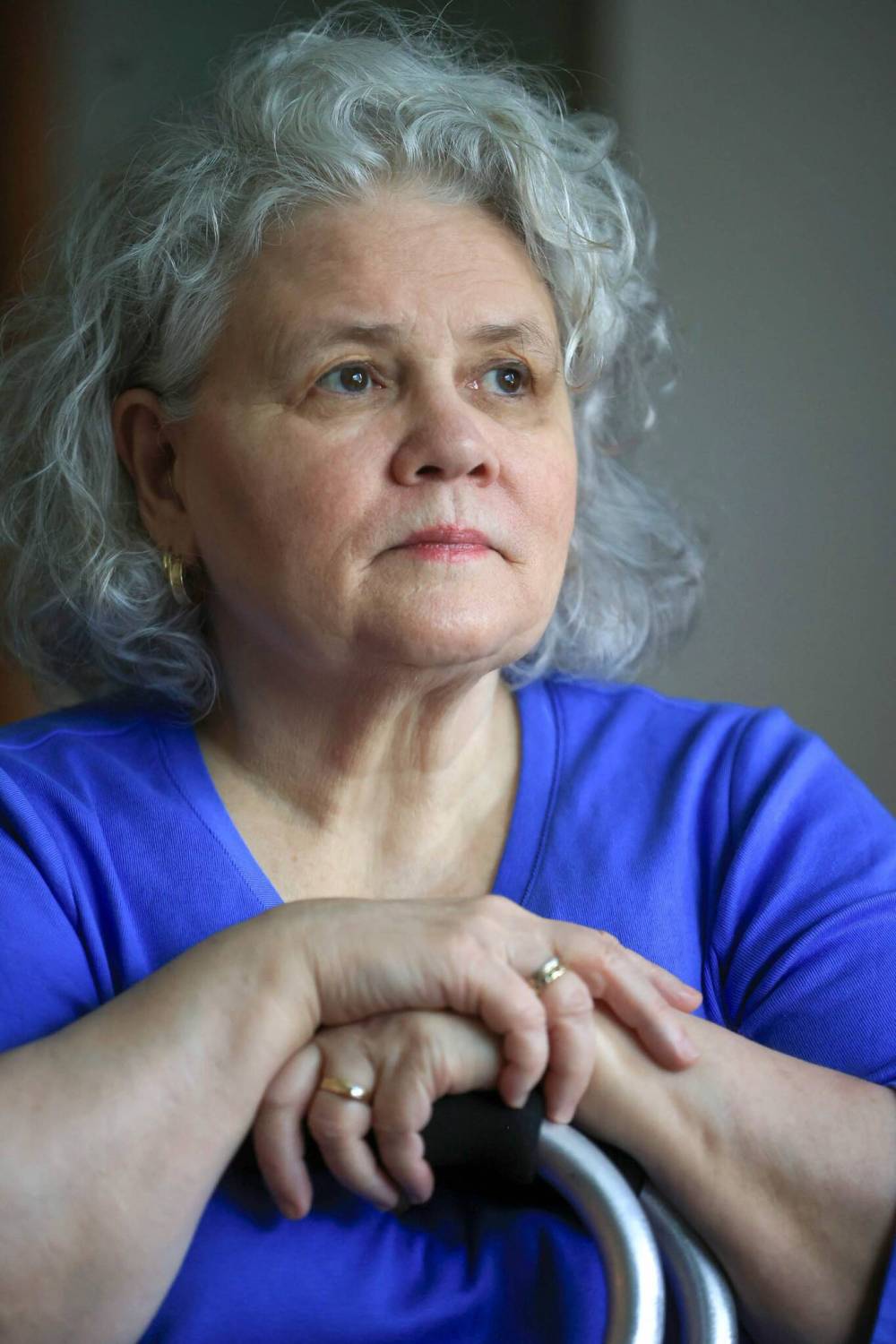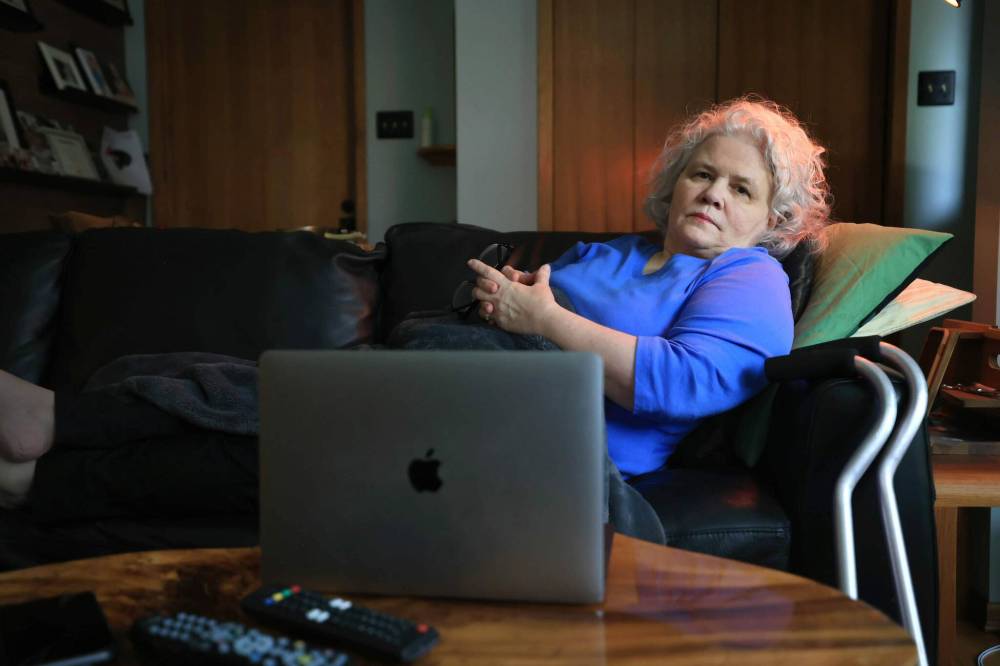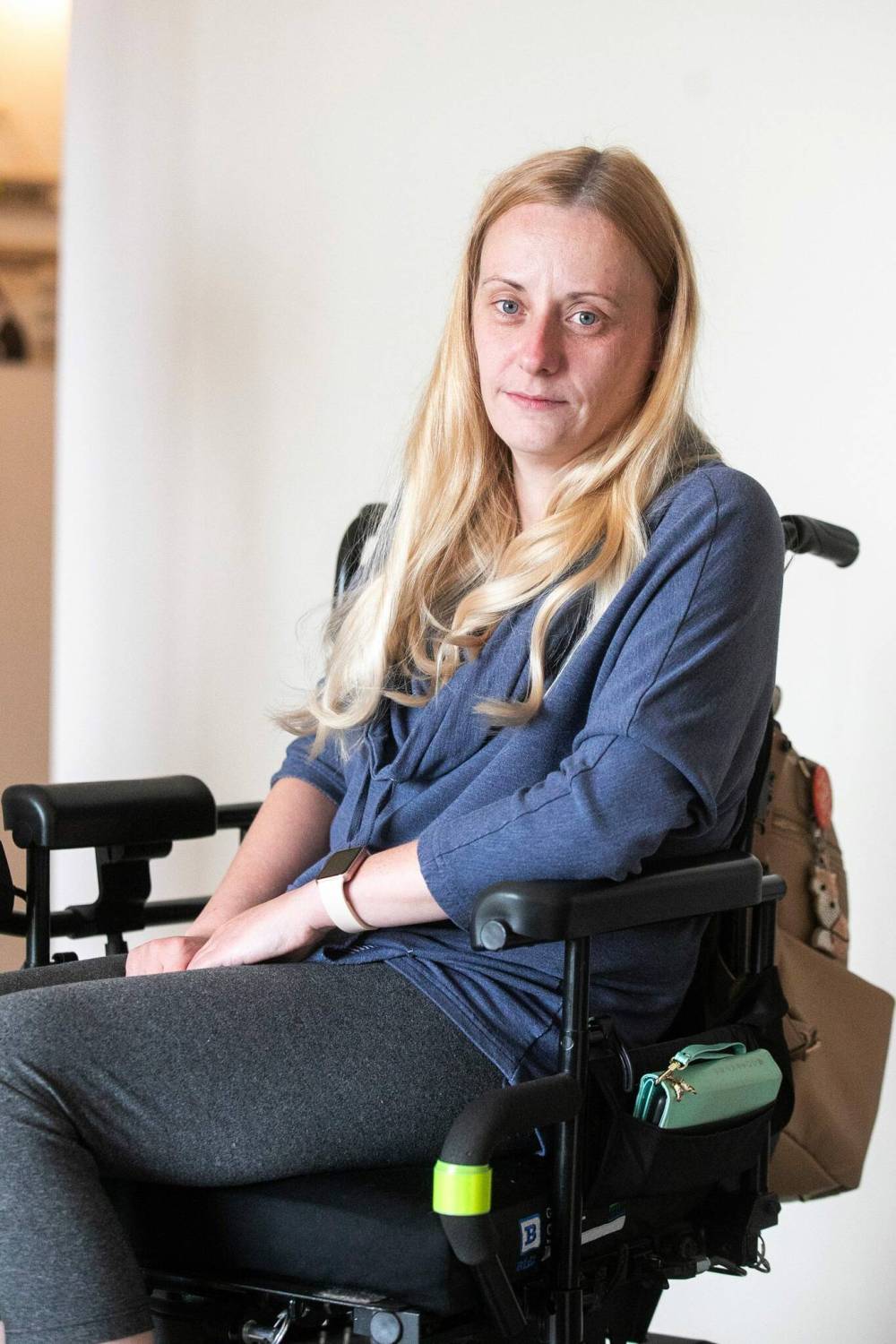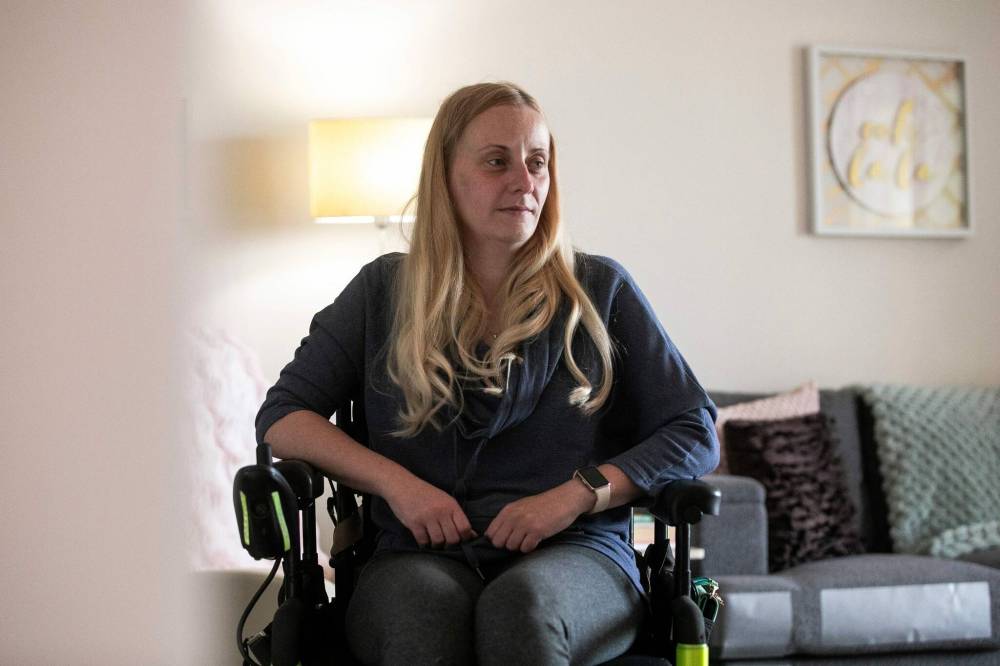Sick and tired More than 20,000 Manitobans suffer from ME/CFS, a long-term chronic disease
Read this article for free:
or
Already have an account? Log in here »
To continue reading, please subscribe:
Monthly Digital Subscription
$0 for the first 4 weeks*
- Enjoy unlimited reading on winnipegfreepress.com
- Read the E-Edition, our digital replica newspaper
- Access News Break, our award-winning app
- Play interactive puzzles
*No charge for 4 weeks then price increases to the regular rate of $19.00 plus GST every four weeks. Offer available to new and qualified returning subscribers only. Cancel any time.
Monthly Digital Subscription
$4.75/week*
- Enjoy unlimited reading on winnipegfreepress.com
- Read the E-Edition, our digital replica newspaper
- Access News Break, our award-winning app
- Play interactive puzzles
*Billed as $19 plus GST every four weeks. Cancel any time.
To continue reading, please subscribe:
Add Free Press access to your Brandon Sun subscription for only an additional
$1 for the first 4 weeks*
*Your next subscription payment will increase by $1.00 and you will be charged $16.99 plus GST for four weeks. After four weeks, your payment will increase to $23.99 plus GST every four weeks.
Read unlimited articles for free today:
or
Already have an account? Log in here »
Hey there, time traveller!
This article was published 26/05/2025 (191 days ago), so information in it may no longer be current.
There is a scene in a season 5 episode of ’80s sitcom The Golden Girls where one of the main characters, Dorothy, who has been battling profound tiredness, confronts the doctor who had failed to diagnose her.
After months of searching for answers, she tells him she finally knows what is wrong with her.
Launching into a blistering monologue, she holds him to account for ignoring her symptoms and making her doubt herself.
“I came to you sick and scared and you dismissed me,” she says, looking him straight in the eye. “You told me I wasn’t sick; you told me I was just getting old.
“Well, I really am sick. I have chronic fatigue syndrome. That is a real illness.”
It’s a moment that will likely resonate with many of those who suffer from the complex and debilitating condition.
Commonly referred to as ME/CFS, myalgic encephalomyelitis and chronic fatigue syndrome is a life-changing disease that affects about 444,000 Canadians.
Classified as a neurological disease in the World Health Organization’s International Classification of Diseases, the long-term chronic condition affects the nervous and immune system, affects more women than men, and children and adults of all ages.
The debilitating condition is characterized by an overwhelming lassitude, extreme tiredness that can see patients confined to their bed for hours on end or housebound for an indefinite period.
Silenced symptoms
Downplayed. Dismissed. Devalued.
In this monthly Free Press series, we’ll explore underdiagnosed, underrecognized and undertreated health issues affecting the lives of women, nonbinary and trans people.
We will share stories and lived experiences, while also raising awareness.
Other symptoms include (but are not limited to) cognitive challenges referred to as brain fog, which can manifest as word-finding difficulties, memory difficulties, and attention and concentration deficits; migraines; light and sound sensitivity; gastrointestinal issues; orthostatic intolerance; thermostatic instability; and sensitivity to chemicals.
Patients often need help with tasks and endure mobility problems and pain and are unable to work.
Bounced from pillar to post, their first port of call is usually a family doctor, who may misdiagnose them, disregard their very real challenges, or direct them to seek counsel from specialists.
The burden of education often lies on the shoulders of the patients, who may find themselves having to convince physicians they are not malingering.
“Theoretically, it should be relatively straightforward to diagnose; there are diagnostic criteria that have been adopted,” explains Dr. Stephen Goulet, an internal medicine specialist who works at St. Boniface Hospital and Grace Hospital.
“The problem is a lot of doctors have learned certain things about it that are no longer useful, that are outdated both in the diagnosis and the treatment.”
One of the primary symptoms of ME/CFS that differentiates the syndrome from someone who is merely fatigued is post-exertional malaise (PEM), which impedes the body and brain’s recovery process, even after using small amounts of energy.
Simple physical or mental activities or a combination of both can leave people feeling completely exhausted and lead to an increase in other symptoms.
“The crux of it is that it is a condition that is chronically fatiguing. It’s not just in someone’s head; I want to make this very, very, very clear,” Goulet says.
When someone with CFS overexerts themselves, they crash, and can end up being bedbound for days or even weeks.
“That really is the (symptom) that distinguishes things because almost every chronic condition under the sun we recommend activity, even pushing yourself and most people end up feeling better. This is the one condition where that’s not the case,” Goulet says.
Getting the correct diagnosis is just the beginning of what can sometimes be a frustrating journey.
“The problem is a lot of doctors have learned certain things about it that are no longer useful, that are outdated both in the diagnosis and the treatment.”–Dr. Stephen Goulet
Although recommendations have been made on how to improve the health-care system for those with ME/CFS, changes have yet to be implemented.
The lack of action is frustrating for those with the disease and those who raise awareness of it.
Founded in 1993, the National ME/FM Action Network of Canada is a charitable organization dedicated to ME/CFS and fibromyalgia (FM) through support, advocacy, education and research.
“Little action has been taken. We need active changing of the system,” says Margaret Parlor, president of the organization.
“If people have certain symptoms and they are going on for weeks, they should be alerted to be careful exerting themselves, they should be diagnosed, they should have an action plan.
“What is key is that people function within their limits and their action plan means support so that they can drop work, they can be put on disability as needs be, long or short-term. It in the best interest of the patient, the family, the employer, the medical profession; everybody benefits.”
Outdated perceptions of the disease persist, including the assumption from both members of the general public and medical professionals that ME/CFS is a psychological rather than a physical condition.
Until recently, ME/CFS was wrongly identified as a psychosomatic illness.
“I try to get the colleagues that I am teaching to be mindful that the assumption they may be holding could get in the way of them being able to fully deal with the person in front of them,” Goulet says.
With no clear indicators as to how a previously healthy and active person develops the disease — although some studies have shown it begins with a viral infection such as the flu or COVID-19 and research shows that up to 50 per cent of people will develop ME/CFS after getting long COVID — it is difficult to adequately treat those with ME/CFS.
Diagnosing the disease
Post-exertional MALAISE (PEM) was identified as a symptom in 2003 in the Canadian Consensus Criteria (CCC), a set of diagnostic criteria used to diagnose cases of ME/CFS.
The National ME/FM Action Network of Canada then commissioned an overview, A Clinical Case Definition and Guidelines for Medical Practitioners, which was published as a booklet in 2005 to help physicians make the correct diagnosis.
Post-exertional MALAISE (PEM) was identified as a symptom in 2003 in the Canadian Consensus Criteria (CCC), a set of diagnostic criteria used to diagnose cases of ME/CFS.
The National ME/FM Action Network of Canada then commissioned an overview, A Clinical Case Definition and Guidelines for Medical Practitioners, which was published as a booklet in 2005 to help physicians make the correct diagnosis.
Founded in 1993, the charitable organization dedicated to ME/CFS and fibromyalgia raises awareness through support, advocacy, education and research.
“The CCC painted a very full picture of what ME/CFS looks like. What was really significant in there is that PEM was recognized as a requirement. Before 2003 that was not a requirement,” says Margaret Parlor, president of the organization.
In 2015, an updated diagnostic clinical criteria for ME/CFS and a new term for the illness — systemic exertion intolerance disease (SEID) — was published by the U.S.-based National Academy of Medicine.
Based on the comprehensive Canadian diagnostic protocols, the U.S. version specified four symptoms — reduced activity levels, post-exertional malaise, sleep dysfunction and cognitive difficulties or orthostatic intolerance, or both — that could be used to identify cases of ME/CFS more swiftly.
Physicians can also refer to a number of other resources to aid with diagnosis.
In 2021, the U.K.’s medical advisory body, the National Institute for Clinical Excellence, published the report Myalgic Encephalomyelitis (or Encephalopathy)/Chronic Fatigue Syndrome: Diagnosis and Management. In it, the institute, which had previously suggested ME/CFS could be treated with exercise, agreed that PEM was real and that exertion could be harmful.
Closer to home, in 2024 Ontario’s Ministry of Health funded the Centre for Effective Practice to develop evidence-based clinical tools for primary-care clinicians to recognize, assess, diagnose and manage the syndrome.
Ultimately, patients have to learn to manage their symptoms.
“Some people will respond to treatment and other people will not — there is no one-size-fits-all. It’s not like there are no treatments, it’s just the pathway to finding something that will help is not straightforward,” Goulet says.
Patients should be supported by a multi-disciplinary approach with access to care not just from a doctor, but a team that includes occupational therapists and physiotherapists well versed in this condition and social workers to help them navigate the system.
“The approach needs to be multi-modal and to help people find strategies to learn to live with this condition as well. Mindfulness- and acceptance-based therapies have shown some promise helping people learn to work within their allotted energy,” Goulet says.
“People need to be mindful of where their sense of worth comes from. Some of the people who are in the worse shapes are the classic so-called A-type personalities who feel worthless if they can’t continue to produce and then a breaker goes off and boom, their energy is gone.”
Studies have compared ME/CFS to end-stage cancers, end-stage heart disease, rheumatoid arthritis and lupus and found from that debilitation point of view, they are essentially on par.
“People have to extract themselves from behaviour patterns that no longer serve them. They really need to pull back from activities that are making it worse,” Goulet says.
“It is very difficult to live in this ableist society, which puts so much emphasis on productivity and working.”
Beverley Friesen, 69, has been living with ME/CFS for 27 years. In her late 30s, the mother of two boys would see her friends juggle work and parental duties and wonder how they were able to do it when she could barely get through the day.
Medical professionals were all unable to identify why she was feeling so “bone tired” all the time.
Ruth Bonneville / Free Press Beverley Friesen on her couch, which she is for many hours during the day due to her condition. Her fatigue has sometimes been so bad that she’s spent 22 out of 24 hours lying down. 
“The fatigue is so overwhelming; all you want to do is nothing,” she explains.
In 2002, at age 46, she visited Dr. Hugh Smith, a cardiologist who was treating her parents and who agreed to see her as a favour to them.
“He wrote in a letter, ‘I suspect she has chronic fatigue syndrome’ and he left it at that. But at least he did that,” she says.
Friesen began researching the condition on her own before eventually joining the Manitoba ME/CFS Support Group, where she is now a board member.
She continued to struggle to get answers and was only officially diagnosed in 2018 at 62.
Friesen says the disease is misunderstood by most, including medical professionals. Her work with the support group aims to raise awareness of the symptoms of the illness as well as the multitude of challenges facing those with it.
“If you knew you weren’t going crazy, if you could just have a diagnosis, you could say, ‘Oh, these are the cards I’ve been dealt and I’m going to get on with it and do the best I can,’” she says.
Her prevailing symptom is the “bone-crushing fatigue” of PEM, which she manages by pacing, making sure she doesn’t pack too much into her days and limiting sensory overload.
“My day has to be very planned; I cannot be spontaneous,” she says.
Her orthostatic intolerance makes it difficult for her to stand for long periods of time, so she does a lot of her work lying down.
“I have spent hours flat in bed, but when I am lying down I can get a few things done.”
Ruth Bonneville / Free Press Beverley Friesen, who was diagnosed at 62 and is now 69, does a lot of advocacy work, including organizing events for the Manitoba ME/CFS support group.
Dealing with feelings of isolation and frustration, as well as the stigma that comes with the illness, was hard at first, but she has learned to cope.
“You try to explain the fatigue to people, but you can’t. People have their pat answers — ‘Oh, just exercise’ — but you can’t. I mean, I even got a dog hoping that the dog walking would give me some exercise. I was so delusional,” she says.
“I have to rest to get energy, which sounds strange because we live in an exercise environment with the media always telling everybody to exercise, exercise, exercise.”
Learning to pace herself has helped Alexandra Wilding, 37, manage her symptoms.
Wilding was in her mid-20s when she was told she had ME/CFS. She suspects her illness stems from a case of mono when she was 17, followed by a bad flu she never recovered from.
Forced to quit school, she found herself bedbound for a few months owing to her exhaustion.
She began to do her own research a few years later after doctors were unable to identify what was wrong with her.
Wilding’s symptoms include fatigue, nausea, irritable bowel syndrome and brain fog — she can’t recall a lot of her 20s — and she continues to have problems with her working memory.
“My dream life at this point is the Average Joe life that people take for granted.”–Alexandra Wilding
The severity of her symptoms have decreased as she’s aged, although she continues to deal with “devastating fatigue.”
“If I have something to do, I do only the necessary things the day before and the day of I do very little else, planning around that one event and banking what energy I can. I plan my entire week and sometimes my month around the two or three things I want or have to do,” she says.
“I walk with a cane for stability — on bad days I get extremely clumsy — and to have something to lean on when the fatigue kicks in.”
Wilding has good and bad days, although the former are few and far between. On good days, she makes sure to plan what she refers to as “happy life experiences” she can hold on to when she’s experiencing her bad days.
“On bad days, around six or seven a month, I feel like my limbs are weighted, like every movement takes so much effort and strength. When the fatigue hits, I can feel it coming. The world starts to blur and I have trouble following what people are saying. I get nauseated, sweaty and breathless, my legs feel like they can’t hold me up anymore. I need to sit down right away or lie down if possible — even if it’s just the backseat of the car or a cold floor — and I need to hydrate.”
Wilding says natural light feels too bright and noises too loud. She feels breathless after getting up to go to the fridge and her head feels like it’s stuffed with cotton batting.
“I have trouble following conversations and working out basic instructions. That is the symptom that bothers me the most; I used to be intelligent and studious but the ME makes me feel like I can’t follow a basic recipe half the time,” she says.
All Wilding wants is to live a normal life; she deals with feelings of shame about how far “behind” she is.
“I have a lot of fear in my life. That (Employment and Income Assistance) will decide I’m actually not ‘sick enough’ and I’ll lose what income I have. That I’ll get a virus like I did in 2004 and my ME will worsen and I’ll lose the little life I’ve managed to build for myself. That my fiancé will get sick of taking care of me or that he’ll get sick of waiting to get married,” she says.
“My dream life at this point is the Average Joe life that people take for granted: a job, going out with friends, doing yoga, going to get groceries without having to plan my week around it. I’ve missed my chance to have a family, but I’d love a quiet life with my fiancé, working as a librarian, able to have independence, some financial security and a body that works with me instead of against me.”
“It is so hard to advocate when you have to deal with the government. No one seems to want to listen.”
Ashley Preece is determined to hold on to her independence. The 42-year-old is on a fixed income and lives on her own. She relies on Meals on Wheels for food delivery and has homecare every other week to help out with her bedding and vacuuming.
Her symptoms first appeared in 2016, when she was in college, training to become a health-care aide. She began experiencing episodes of extreme fatigue, nausea, weakness and dizziness. She pushed through, but it quickly became impossible for her to keep studying.
MIKAELA MACKENZIE / FREE PRESS Ashley Preece, who has ME/CFS, is frustrated by doctors questioning her use of a wheelchair.
Multiple visits to her family doctor resulted in a diagnosis, but she continues to deal with physicians who are not aware of the condition.
“Every time I end up in urgent care for something, the doctors want me to spell it out for them. And then they question why I am in a wheelchair and that gets frustrating. I don’t think they would question someone with MS or Parkinson’s why they were in a wheelchair,” she says.
Preece spends most of her energy fighting for income security and resources. She has learned to advocate for herself when it comes to accessing funds.
When the province’s new disability support program was introduced in 2023, she was excited. The system was working perfectly, until suddenly it wasn’t.
“We started out having workers and it was great. We could get hold of them. And then all of a sudden they cut all the workers and we all had to call a main line and you can’t even get through to them,” she says.
She is getting IV Immunoglobulin therapy for her postural orthostatic tachycardia syndrome, a symptom of her ME/CFS and found herself stranded one day when she couldn’t reach anyone to organize transportation after four days of calling to arrange it.
She eventually had to pay out of pocket for transport.
MIKAELA MACKENZIE / FREE PRESS Ashley Preece, who has ME/CFS, in her home on Tuesday.
“I have had such problems with this new disability program and no one seems to want to listen. I have written to the minister, I have written to the head of the disability program. It is so hard to advocate when you have to deal with the government,” she says.
Getting in touch with support workers to ensure her basic needs are met has become akin to a full-time job for Preece. Her concerns regarding the lack of communication have yet to be addressed.
A government spokesperson said all requests for transportation benefits through Manitoba Supports for Persons with Disabilities are reviewed and approved in the order they are received. The program receives more than 300 phone calls, 200 emails and 25 in-person visits per day, the spokesperson said, and program staff are working to assess and resolve service issues.
av.kitching@freepress.mb.ca

AV Kitching is an arts and life writer at the Free Press. She has been a journalist for more than two decades and has worked across three continents writing about people, travel, food, and fashion. Read more about AV.
Every piece of reporting AV produces is reviewed by an editing team before it is posted online or published in print — part of the Free Press‘s tradition, since 1872, of producing reliable independent journalism. Read more about Free Press’s history and mandate, and learn how our newsroom operates.
Our newsroom depends on a growing audience of readers to power our journalism. If you are not a paid reader, please consider becoming a subscriber.
Our newsroom depends on its audience of readers to power our journalism. Thank you for your support.
History
Updated on Monday, May 26, 2025 10:07 AM CDT: Adds web headline
Updated on Monday, May 26, 2025 10:21 AM CDT: Changes formatting, rearranges photos
Updated on Monday, May 26, 2025 10:52 AM CDT: Adds fact box
Updated on Monday, May 26, 2025 11:37 AM CDT: Tweaks formatting, adds government response.
